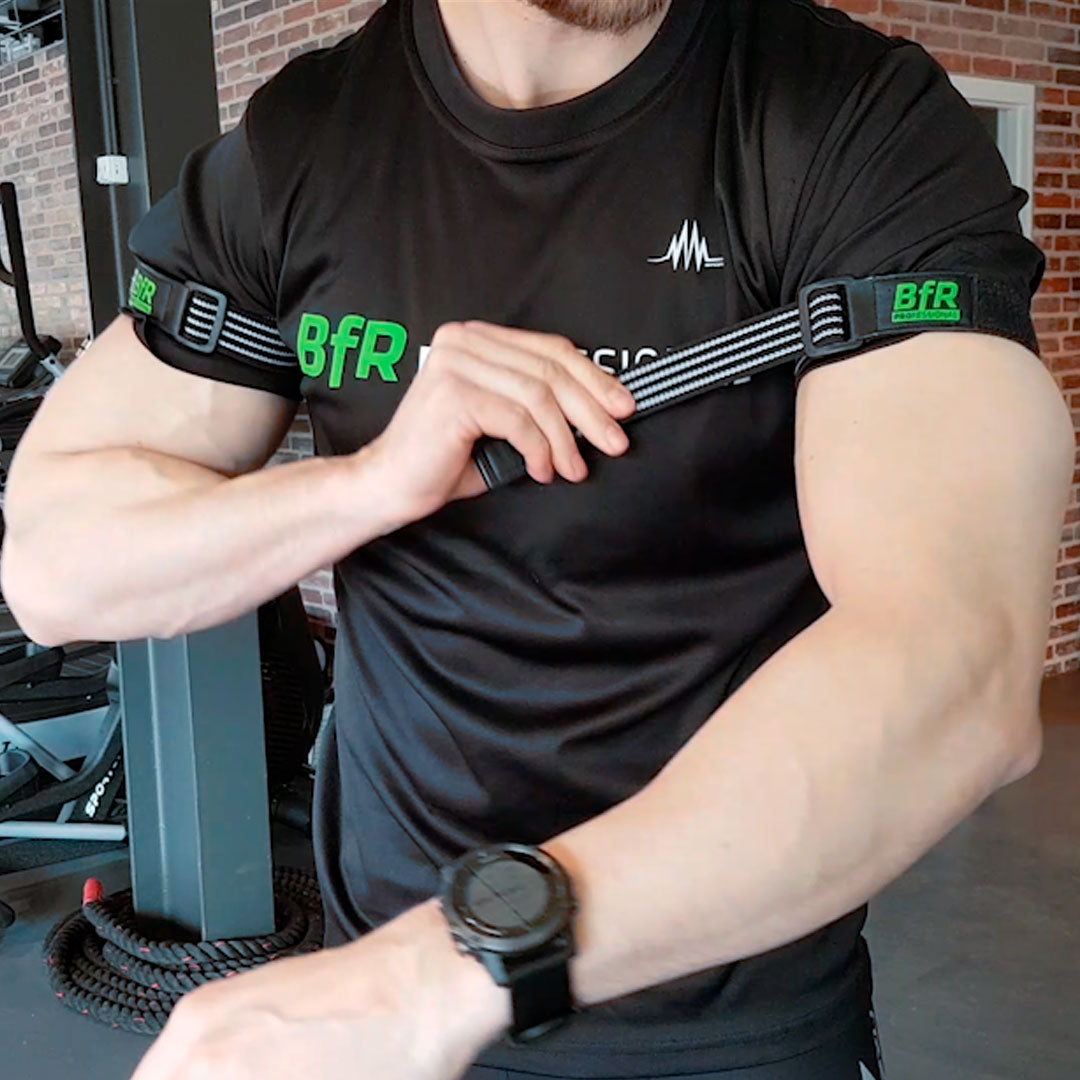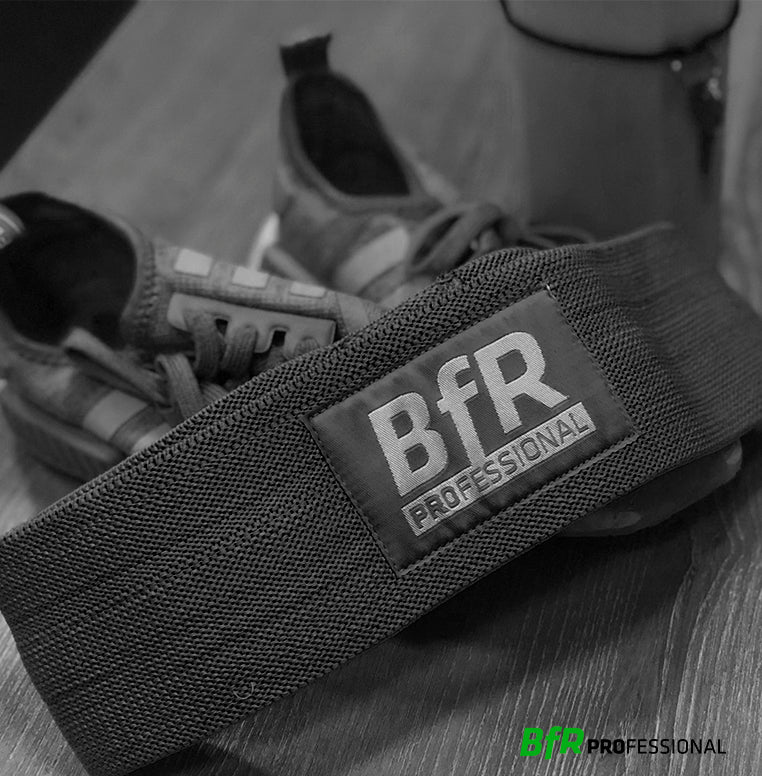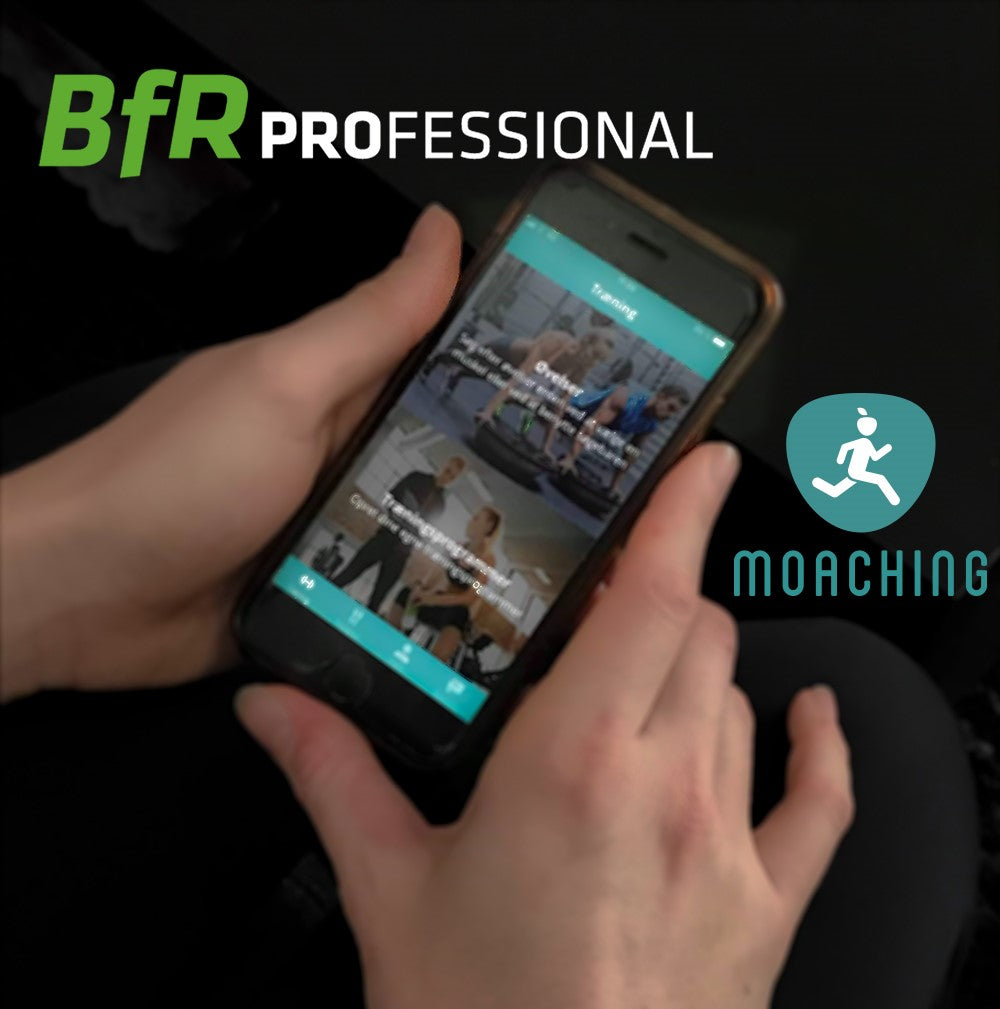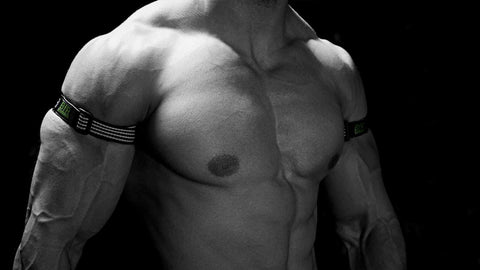
We are very happy to announce our latest partnership with another Danish fitness startup Moaching!
Besides having developed a great fitness app which can now be downloaded for free on the App Store, then the founders are also from our home town of Aarhus – extra bonus points there, of course. 😉
How Can You Benefit From This Partnership?
All you need to do is download the Moaching app which is simple and easy to do and you will have access to hundreds of exercises with both written and video instructions.
Among these exercises, you will find more than one hundred exercises including videos where products from BfR Professional is being used to perform blood flow restriction (BFR) training.
Simply type in the search field “BfR” or “okklusionstræning” in Danish and you will find all the BfR videos. Afterwards, you can then pick and choose which of the exercises you would like to add to your training program. Easy and simple to use!
Together with Moaching, we will continuously update the platform with more exercises and inspiration for you to enjoy with our products making it a one-stop platform for you to find inspiration for your next workout. 😊
If you're looking for a few tips before getting started with BFR training or occlusion training as it is also popularly called then check out this blog post.
In Moaching’s own words this is what their new awesome app can offer you.
What Is Moaching?
Moaching is both an application for exercisers, as well as a website that consists of a tool for specialists, such as personal trainers and dieticians.
Moaching offers a large training catalog, with thousands of exercises that are constantly updated. Here you can search for specific muscle groups, read about different exercises and see related videos for correct execution.
In here you will also find lots of exercises where BfR Professional equipment is used. Training programs are customizable, so you can create exercise programs with the exercises you want.
The application’s food catalogue contains thousands of foods/ingredients where you can easily find and enter what you have consumed during the day. From here, the calorie counter does the rest of the work!
The calorie counter displays your recommended daily intake based on your current goals, and from there you can follow your progress to ensure you reach your goal.
Moaching creates the ultimate overview of your progress to make your goals more manageable.
Note: At the time of writing, Moaching is only available for iOS but Android will soon follow along with other languages.
Visit our webshop here to get your own BfR bands, wrist wraps or leather lifting straps for your next workout.
All the best,
Lars & Martin
Team BfR Professional
What to Use
Blood flow restriction training was originally performed using an inflatable cuff, known as a KAATSU band, that was linked to an electronic monitor. Unfortunately, KAATSU devices are expensive, complicated to use and not easily transportable.
It is possible to use knee wraps or a similar elastic bandage; however, it is difficult to achieve a correct and even pressure when using these solutions since they are often too long to handle (2+ meters).
Instead, we recommend using a purpose designed strap or band for BFR training. That way, you are able to more accurately control the pressure and easily replicate it in future workouts.
Moreover, you avoid having to deal with the unnecessary slack dangling around your arms or legs when doing your exercises which is often the case when using knee wraps.
Advocates for using Kaatsu equipment argue that you will never be able to find as accurate a pressure when using practical BFR training bands compared to Kaatsu equipment.
Even though that might be true, we believe it comes down to a matter of practicality and affordability. Just always remember to follow the appropriate guidelines and rather apply a lower pressure compared to a higher pressure, if you are in doubt.
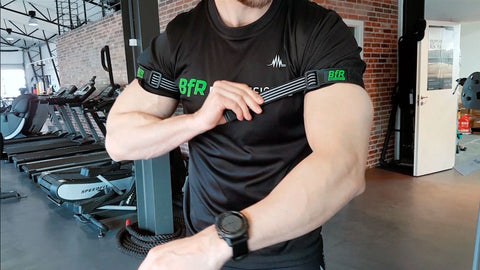
Where to Wrap
The researchers within the field of BFR training now broadly agree that the correct placement for the band or strap is proximal to the torso meaning as close to the heart as possible.
For the upper body, place the strap just below your armpit, between your shoulder and bicep/triceps muscles. For the lower body, place the strap at the top of your thigh just below your glutes.
Note: if you are using knee wraps rather than a BfR Pro LEGS, make sure that when you wrap you do not end up wrapping the entire thigh – as this increases the risk of completely occluding the arteries. Wrap the band whilst trying to keep the pressure as even as possible as you add each layer.
How Tight to Wrap
For both your upper and lower body, it is suggested that you wrap to 4-7 out of 10 in tightness; with 10 being as tight as possible. You shouldn’t feel any numbness or tingling once you’ve applied the strap.
If you are not feeling and numbness or tingling but are still unsure whether you’ve wrapped too tight, you can easily check by doing a capillary refill test. Once you’ve applied your strap, press down on the palm of your hand with one finger until your skin turns white. If you have your straps applied correctly, you should see normal colour return in no more than 2 seconds.
When you are first starting with blood flow restriction training and not 100% sure on your pressures, it’s safer to be a little loose than too tight. Researchers wrapped subjects at either 40 or 80% tightness and measured the effect on muscle growth & strength.
Interesting, both pressures produced the same amount of gains. So wrapping a little lighter will still give you the gains you’re after without running the risk of complete arterial occlusion.
Any questions hit us up on Facebook here or even better @bfrpro on Instagram.
Team BfR Professional
Winter is coming...
This means that you might have started planning your great escape to warmer destinations in the cold winter months, if you live in Northern Europe or North America like we do.
Or maybe you actually love the snow and cold weather so you're planning to pack up the car and go skiing in the alps somewhere around Europe.
But maybe there’s one thing you’re still worried about… disrupted gym schedules, unhealthy food tempting you at every turn and not an adequately stocked gym anywhere in sight.
How could you possibly keep up a consistent routine and stay in shape whilst travelling?
Well, there is no need to fear any longer; so long as you don’t leave your workouts to chance. Simply grab our popular Traveller Pack with the BfR bands and Elastic Training Tube – designed to fit easily into your carry-on luggage allowing you to stay fit, wherever your travels take you.
BFR and Resistance Tube Training
Elastic resistance tubes have long been the preferred piece of equipment for any travel workout routine. They’re lightweight, incredibly easy to set-up & allow you to perform just about any strength training exercise.


By adding in blood flow restriction techniques into your resistance tube training, you can take your travelling workout to the next level. Here’s how.
Faster Workouts:
Blood flow restriction training allows you to complete a high impact workout in an extremely short amount of time by rapidly increasing muscle protein synthesis. This type of training activates both type I and II muscle fibers even though the workout protocol for BFR training is light weights (20-50% of 1RM). Despite this fact, it has been proven time and time again that this method is very efficient for hypertrophy (building muscle).
Based on the latest scientific research within the field, we recommend working out with continuous pressure keeping the bands strapped on for a maximum of 10-15 minutes. Combine low-load BFR training with traditional heavy load strength training to maximise results.
Lighter Weights:
With only around 20% of your one-rep max, BfR straps allow you to get the same results as if you were lifting 70% 1RM; making it the perfect companion to use alongside an elastic resistance tube workout.
Simply adjust the resistance of the elastic training tube by either moving further away from the place where the tube is mounted in pull/push (e.g. around a pole or pillar). Or in exercises where you stand on the tube then simply increase the width between your legs to adjust the strength making it tougher to pull against yourself.
Shorter Recovery Times:
Blood flow restriction training techniques also have much faster recovery times; meaning DOMs aren’t going to get in the way of enjoying your trip.
However, start with only 20% of what you believe to be your one-rep maximum and do one exercise with straps on while combining it with normal exercises without straps.
After a couple of weeks you're muscles will adapt to this new type of training and then you will be able to do more BFR exercises without it being too painful.
As a result, you’re able to get more from your resistance workout in less time; giving you more time to spend basking in the sun or hitting the slopes.
Check out our training video below for inspiration on how to use the Traveller Pack.
The GluteBuilder - How does it work and what does it do?
Have you ever been wondering why the GluteBuilder is such a popular tool? Or how it even works? Well, with a new BfR Pro family member soon to arrive, we thought about sharing the knowledge with you.
The GluteBuilder is an amazing tool for optimizing your leg workout and building on your glutes. Besides that, it also helps you to improve your technique in lower body workout.
So who is glute training appropriate for?
- For running. The gluteal muscles is one of the power muscles for running.
- For a knee injury or knee related problems. It protects the knee when your leg is extended.
- For people who struggle with pelvic girdle and femur stability.
Maybe you are one of those people who hasn't been focusing too much on your glutes. So what is the the signs of having weak glutes?
Knee Pain
Faulty mechanics
Anterior knee shift (knees coming forward):
- Anterior knee shift (knees coming forward
- Lack of hip hinge
- Difficulty pushing knees out
-
Knee valgus (knees collapsing inward
Lack of soreness after training legs
Weak ankles and feet
- Excessive pronation during running or squatting
Tight hip flexors
- Muscular imbalance
Hip drop
Remember; you can use your GluteBuilder in the gym or at home for a quick workout. That's entirely up to you. Besides that, the GluteBuilder is an amazing travelling companion. Easy to pack and doesn't take any room in your suitcase or backpack.
BfR Professional wishes you a great weekend!

Over the last couple of years, blood flow restriction training has received a lot of positive attention as a result of the amazing increases to size & strength it offers. But many people are still in the dark about how BFR training works. Here are 5 key tips you must know when beginning BFR training.
Warm-Up Correctly
Blood flow restriction training workouts are performed at intensities that are normally used during warm-up sets. As a result, it is suggested that you perform a light warm-up of cardio – such as walking or light cycling – followed by 15 unwrapped repetitions with the weight you will use for your first set of blood flow restriction training.
Choose a Suitable Strap
To perform blood flow restriction training, you will need a device to – you guessed it – restrict blood flow to the limb you wish to train. Whatever you choose, you need to be sure you are only restricting the return blood flow, rather than completely occluding (stopping) it.
There are a number of different suggestions of what to use floating around the internet; from knee wraps to over-sized elastic bands. However, to ensure as accurate a pressure as possible when performing practical BFR training, we suggest purpose designed solutions like our BfR Pro ARMS & BfR Pro LEGS straps.


Once you’ve chosen your bands, make sure you read about where to wrap & how tight in our full How to Wrap Correctly for Blood Flow Restriction Training guide.

Lift MUCH Lighter
This is possibly the biggest advantage of blood flow restriction training – massive increases in muscle size at much lower intensities of weight. Considerable research has been conducted on the optimum weight to lift whilst BFR training depending on the type of goal you are trying to achieve.
To work your slow-twitch fibres (those used for endurance) you should lift around 20-30% of your one-rep max (1RM). Meanwhile, some studies suggest to increase performance of your fast-twitch fibres (those for explosive power and strength) you should lift around 40% of your 1RM.
Adjust Your Reps and Rest Periods
Whilst you are going to be lowering the intensity of weight you’re lifting; you’re going to be upping the intensity and volume of your workout. Blood flow restriction training uses higher metabolically demanding sets & reps with a much shorter rest period between (typically 30-45 seconds).
Aim for 15-30 repetitions for 4 sets with only 30 seconds rest between each set. Concentrate as you squeeze out each rep and feel the movements working the muscles. Squeezing out lifts and shorter rest periods continue to pump blood into your muscle, increases lactic acid build up & create significant growth.
Don’t Over Do It
BFR training results in greater fatigue to the muscle directly following the workout. Therefore, it’s important that you adjust your recovery accordingly but compared to heavy lifting then there is less muscle damage when doing low load BFR training.
Studies have shown that no increases in muscle damage continue longer than 24 hours after a BFR workout[1] meaning it is safe to be performed every other day at most; but the best gains in muscle size and strength have been found performing 2-3 sessions of BFR per week.[2]
Do be aware, however, if you are just starting blood flow restriction training or are unaccustomed to such high-repetition sets, you may need slightly longer to recover from such metabolically demanding training. To begin with, only use BFR training once or twice a week until you feel your muscles are recovering around the 24-hour mark.
Summary
- Be sure to warm up with light cardio & 15 unwrapped reps
- Choose a quality strap and make sure it is applied correctly
- Calculate your new training weight
- Perform longer sets with shorter rest periods
- Listen to your body & don’t over-do it, especially when first starting
Team BfR Professional
Sources:
- Wilson et al, Practical blood flow restriction training increases acute determinants of hypertrophy without increasing indices of muscle damage, The Journal of Strength & Conditioning Research, (2013, 27(11)) 3068-3075.
We all know the old adage that “prevention is always better than a cure”; but if you’re already laid up with an injury, it’s not the most useful advice.
Recovering without motion or resistance training during your rehabilitation will cause your muscles to begin to atrophy and waste away. According to a study published in the International Journal for Sports Medicine, atrophy causes a 35% degeneration of muscle within the first week of immobilisation. However, those with injuries or ill patients with muscle weakness are stuck in a catch-22 situation from being physically active.
By using blood flow restriction techniques in your rehabilitation routine, you’ll be back into your training/top form quicker.
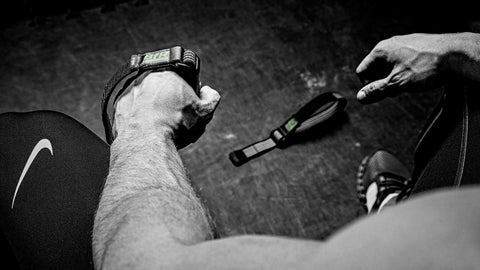
Who can benefit from Blood Flow Restriction Training?
The key to BFR’s popularity is the ability to safely and quickly deliver increased muscle hypertrophy (size), increased strength and increased endurance without strain on a particular joint or without having to lift heavy weights.
Researchers at the Brooke Army Medical Centre in Texas have seen 70-80% increase in strength gains in just 2 weeks – numbers previously unheard of in conventional rehabilitation.
This makes blood flow restriction training perfect for anyone looking to recover from almost any muscular related injury; especially those previously unable to perform traditional heavy strength exercises at 70% of one-rep max (1RM).
Current effective rehabilitative applications of blood flow restriction training include:
- Athletes recovering from injuries such as rotator cuff or ACL injuries;
- Patients with arthritic joints;
- Post-operative cases;
- Older adults at risk of sarcopenia;
- Chronic muscle weakness or atrophy; and
- Injured military or service personnel.
How Blood Flow Restriction Training Works
Blood flow restriction training involves applying specialised restriction straps to the injured limb to partially restrict blood flow whilst exercising. In turn, the restriction causes the now oxygen-deprived slow-twitch fibres within the muscle to rapidly fatigue. This forces your body to engage the fast-twitch fibres which have the most potential for growth.
Typically, fast-twitch fibres are only engaged through heavy weight lifting or significant endurance training. With blood flow restriction training, however, you are able to achieve the same result using much lighter weights – around 20% of 1RM.
Interested in finding out more? Read our more in-depth article about How Blood Flow Restriction Training Works.
How to perform Blood Flow Restriction Training?
In the past, blood flow restriction training would only be available to you if you were able to attend a KAATSU training facility and be assisted by a certified specialist. A difficult and costly procedure for most injured patients.
With new purpose built solutions such as the BfR Pro product range, patients are now able to enjoy the same rehabilitative effects of BFR workouts; without supervision of an exercise specialist from the comfort of their own home.
However, we advise anyone who is suffering from an injury or experiencing any pain to consult their physician or local health professional to determine if BFR training is an appropriate step in your recovery.
So if you’re worried that your current injuries are going to cause you to lose you gains or competitive advantage, or perhaps a chronic trauma that conventional rehabilitation has failed to heal, then injury blood flow restriction bands and workouts could be your answer.
Team BfR Professional

With all the popularity and hype which blood flow restriction (BFR) training is receiving for its accelerated development of both muscle strength and mass, you’ve probably heard the terms blood flow restriction training, occlusion training or KAATSU training floating around online or in your local gym.
If you’re still unsure exactly what BFR training is or how to perform it, then this post is for you.
Terminology: BFR vs Occlusion vs KAATSU
For safety reasons, we need to first quickly address a few terminology issues.
You may see the terms blood flow restriction training, occlusion training and KAATSU training being used interchangeably – but that’s not strictly correct.
Occlusion training involves completely stopping the flow of blood into a part of the body. Occlusion training is extremely discouraged as it can result in damaged arteries, nerves, muscles, veins and an increase in risk of blood clots.
Whilst both blood flow restriction training and KAATSU training differ by only modifying blood flow rather than stopping it. KAATSU training uses expensive pneumatic tubes, cuffs and electronic monitors and requires a certified specialist to monitor you during your workout.
Blood flow restriction solutions, such as BfR Pro ARMS or LEGS, on the other hand, are simple to use and can easily be added to your workouts to maximise results. In other words, this is practical BFR training which means you adjust the pressure of the bands or straps yourself.
The history
KAATSU training was originally discovered in the 1960’s in Japan by scientist Yoshiaki Sato. Since then, there have been now hundreds of scientific studies from Japan, Denmark, Norway, England and USA researching the effects of blood flow restriction training.
The research to date has found that BFR training promotes muscle hypertrophy and strength gains more effectively compared to traditional low load weight lifting (10-30% of 1RM). In some research it has even provided better results than heavy load weight lifting (60-85% of 1RM) but the best response has been proven to be by combining low load BFR training with high load strength training.
A simple Google Scholar search about blood flow restriction training will provide you with plenty of academic articles on the topic to browse through.
What is blood flow restriction training?
Blood flow restriction training is a technique using straps around the top of your limbs in order to restrict blood flow to the veins but not your arteries. By doing so, you are allowing blood to enter into the muscle but not letting it leave again. This results in a massive increase in cell swelling (or “pump”) and a "danger" response in the muscle cells triggering it to restructure and become larger.
BfR straps also work to trap lactic acid within the muscle, creating an additional anabolic response which turns on protein synthesis. This metabolic stress is believed to play an important role in the beneficial effect of BFR training. These metabolites are implicated in creating a hypertrophic response including lactate, inorganic phosphate, and hydrogen ions.
Read more about how muscle fibres react during blood flow restriction.
Read more about blood flow restriction training and muscle hypertrophy.
What the scientific evidence shows
There have been numerous studies conducted into the benefits and efficacy of blood flow restriction training. Of interest to most people are the increased speeds with which muscle growth can be achieved.
A Danish study in 2012 researched whether BFR training could produce more efficient results than traditional resistance training (normally resulting in 15-25% muscle increase after 3 months). The study found that the subjects undergoing training with blood flow restriction achieved 35-40% muscle increase in only 3 weeks.
A similar study conducted with British elite rugby players in 2014 compared regular resistance training with the same training with added blood flow restriction. The study found that BFR training resulted in players’ squat strength, bench press, jump power and sprint time improving by 200% (Cook et al, 2014).
Is BFR training safe?
The short answer is: Yes, blood flow restriction training is safe; but there are a two key precautions you should take to avoid the potentially harmful effects which can come from accidently occluding your muscles or over training.
We’ve seen some YouTubers suggest using everything from knee wraps to bicycle inner tubes to restrict blood flow just to save a penny or two. But applying BfR straps correctly for accurate, consistent & even pressure on your muscles is easier said than done with make-shift straps (not to mention the risks you run of totally occluding the muscle!). Be sure to choose a quality-built product like the bands from BfR Pro which allow for easy application of strap to find the right tightness and quick release features, should you want to remove your straps in a hurry.
When performing a BFR workout, you are going to be dropping the weight considerably. Most blood flow restriction workouts utilise a weight of 20-40% of your one-rep max (1RM); or alternatively, around 40% of what you normally lift. You’ll also be focusing on a higher repetition range – around 15-30 reps per set – with short rest periods of around 30 seconds.
Take a look at our blood flow restriction workout suggestions for more ideas on how to incorporate BfR into your training. And don’t forget to share your personal success stories with the BfR family on Facebook, Instagram or Twitter using @bfrpro and #bfrpro.
Team BfR Professional

You’ve probably heard of blood flow restriction (BFR) training; or perhaps seen someone performing BFR exercises in the gym. It’s one of the latest & greatest muscle-building techniques; but chances are you only have a rough idea about how it works.
In this article we are going to dive deep into the specifics of what’s happening to your muscles when you perform blood flow restriction workouts; and how it helps you achieve your goals of increased size and strength.
Size, Strength & Muscle Fibres
Increases in muscle strength and size occur when our muscle fibres are put under stress and the body is required to respond, repairing the damaged areas by making then stronger and larger.
Broadly speaking we have two types of muscle fibres, creatively named by scientists as Type I and Type II fibres. Type I muscle fibres are called slow twitch muscle fibers and are built for endurance and help enable long-endurance feats such as distance running, while fast-twitch muscle fibers (Type II) fatigue faster but are used in powerful bursts of movements like sprinting. Once fatigued, Type II fibres are activated and these type II fibres provide strength & contribute most to the appearance & size of your muscle.
Once you’ve applied the band, your arteries will still be open to deliver blood to the muscle, but because you have restricted blood to your veins. The veins are the ones transporting blood back to your heart so by restricting them, it means that the blood can flow to the muscles but cannot leave. From this moment, the muscle will begin to facilitate growth by stimulating muscle protein synthesis.
The Mechanisms of BFR Training
Metabolic Stress
Metabolic stress is identified as one of the three primary causes of muscle hypertrophy (others being muscular tension and muscle damage). The muscular stress signals the muscles to grow and by using low load training with BFR you can significantly optimise your workout compared to low load without BFR and similar levels of metabolic stress compared to high load/intensity workout (>60% of your 1RM).
The best thing about occlusion training is that you can achieve the results of high load training but without the heavy lifting which may be too strenuous for some individuals. However, with that said, research show that you achieve the most optimal performance by combining low load with BFR and heavy load without BFR training.
Cell Swelling
As the BFR straps have stopped the veins from moving blood out of the muscle and you begin to lift, you’re going to start feeling the muscular pressure rising significantly. As the muscles become more engorged, they increase in size - roughly 11.5-12% directly after a BFR workout - and place additional stress on the cellular walls.
As you perform your workout, you will begin to produce muscle metabolic by-products such as lactic acid and hydrogen ions. Due to the positioning & effect of the BFR bands, the lactic acid also becomes trapped in the muscle. Fortunately, these metabolic by-products are in-fact anabolic and assist in protein synthesis to stimulate muscle growth.
In other words, due to the workout with occlusion bands it causes the level of fluids to increase in the muscles which will increase cellular swelling response. This stress leads to a protective response, releasing anabolic hormones and causing the muscle to adapt and grow.
Growth Hormone Release
In this study, low-load BFR training to failure caused an increase in growth hormone 290x higher than resting levels, and approximately 4x higher than low-load training to failure without BFR. These are quite remarkable results which should be taken into consideration before deciding that BFR training is "not something for me".
Low Oxygen Levels and Type I Fatigue
The accumulation of these by-products limits the working muscles’ ability to use oxygen; and when a muscle is increasingly deprived of oxygen, the body’s rate of anabolic response increases.
By continuing to train whilst exposing the muscles to a build-up of lactic acid and low oxygen levels for extended periods of time, the Type I muscle fibres experience rapid fatigue. As a result, Type II fibres are forced to activate, enabling you to begin working on causing muscle damage to Type II fibres easier and faster.
This is not an exhaustive list of the mechanisms that BFR has on the human body when working out but should give you an overview of some of the essentials for moving ahead and trying it out for yourself in practice.
Team BfR Professional

BfR Professional Now Partners with VIRUS!
We are thrilled to announce our newly formed partnership with the American clothing company VIRUS. One of the reasons for this collaboration is that both VIRUS and BfR Professional share the vision of creating quality products for the modern athlete in you.
What does this partnership mean for our you?
With every purchase of a BfR product you will now receive a 10% discount code that you can use on the European VIRUS website! This way you get your new BfR workout gear and a discount on new sports clothing. Pretty cool, right?
Please note: The discount is only valid for the VIRUS EU website.
Who are VIRUS?
VIRUS is a clothing brand devoted to creating quality up-to-date fitness wear. Pink. Gray. Male. Female. Bright colours and cool design. Virus has it all. As active wear is an important part of your workout, it gives you flexibility as well as comfort, so you can focus 100% on your workout. VIRUS active wear has been tested on athletes and in real-life conditions and created to suit your needs by keeping up with the latest trends and technologies in the active wear industry.
You can check out their collections at https://eu.virusintl.com/
So go crazy and purchase your new fitness wear and gear!
Lars & Martin
Team BfR Professional
See you at Newcomers?
Fancy looking at some seriously big muscles and well-proportioned bodies? Or maybe testing your own strength against that of the pros?
Humble as we are, we’re not talking about the BfR crew here – although we will be playing a part. On 31 March and 1 April, BfR Professional is to be found at Newcomers 2018 in Herning. In case you don’t know, this is the annual fitness fair for all upcoming athletes and bodybuilders in Denmark.
Try out our BfR Pro gear or ask us about training hacks
At BfR, we’ve dedicated every minute of our time to help you discover your potential and reach your personal fitness goals. And 2018 is no exception!
Last year's Newcomers proved a big success for us: At our stand, we had loads of curious people asking about what occlusion training - the latest fitness trend - could do for their workout. The extra bold ones even volunteered for our squats and biceps contests.
So don’t miss out on the chance to talk to us in person, learn about occlusion training (aka. BFR training) or try out our exclusive BfR Pro straps for arms or legs. Just like last year, you’ll get the chance to win some of our BFR products. Male or female, fit or fighting to be so – you can benefit from occlusion training. Simple concept, intelligent training, as we put it.
Bring a friend or two and go seek us out at Newcomers in Herning.
Go grab 2018 by the throat!
Team BfR Professional


